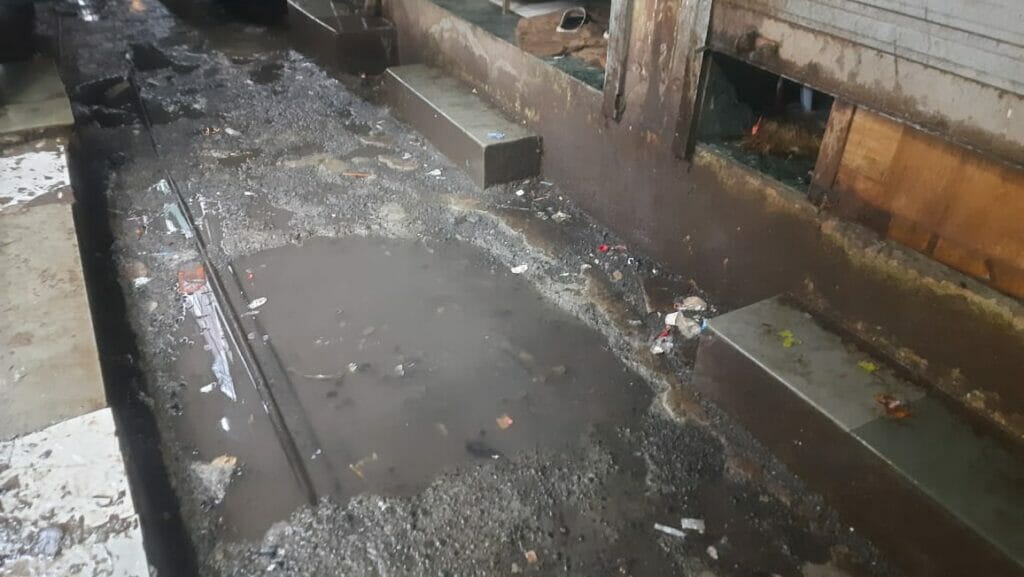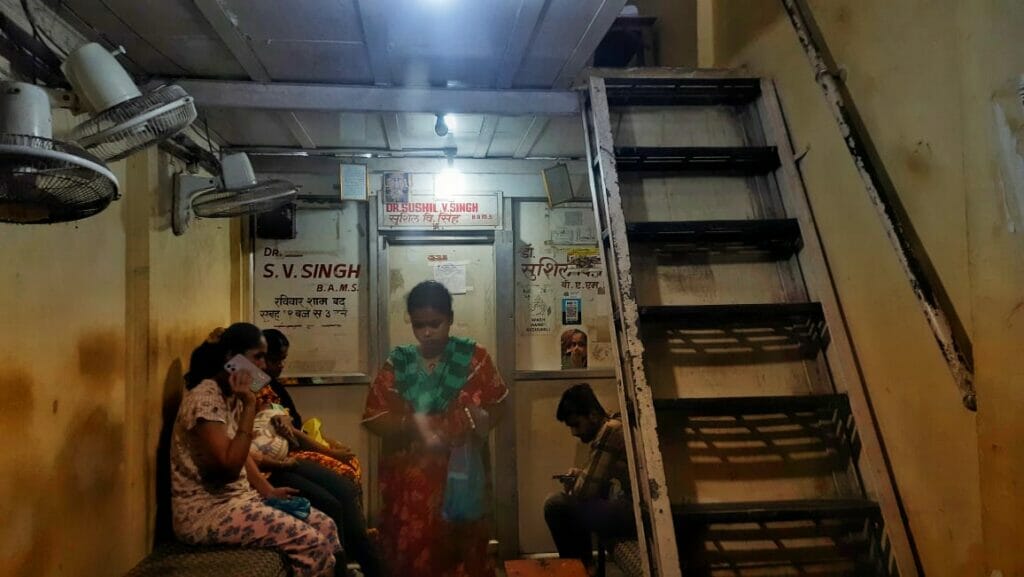Farzana Shaikh, a citizen from Kalina, Santacruz, worries as most of her family members catch stomach illnesses. As soon as she opens the water taps, only muddy water comes out. “During monsoon season, drinking water becomes contaminated; we cannot use it for drinking. We buy Bisleri for drinking, as the BMC water that comes into our home is very dirty. This happens every year in our building; people in my own house have diarrhoea and other stomach infections,” says Farzana.

Malaria, dengue, leptospirosis, chikungunya, gastroenteritis, hepatitis, and H1N1 are some of the main diseases that spread during the monsoon. The data released by BMC as of August 1st says that this year there have been a total of 721 cases of malaria, 377 lepto cases, 579 dengue cases, 1649 gastro cases, 138 hepatitis cases, 24 chikungunya cases, and 86 H1N1 cases.
| Diseases | Cases in July-2022 | Cases in June-2023 | Cases in July-2023 (01 July Till 30 July) |
| Malaria | 563 | 676 | 721 |
| Lepto | 65 | 97 | 377 |
| Dengue | 61 | 353 | 579 |
| Gastro | 679 | 1744 | 1649 |
| Hepatitis | 65 | 141 | 138 |
| Chikungunya | 2 | 8 | 24 |
| H1N1 | 105 | 90 | 86 |
Major rise in cases of Lepto and Gastro
Compared to last year’s data, leptospirosis and gastroenteritis are the two diseases that have seen a massive rise this year. In July 2022, there were only 65 cases of lepto, while this year, the cases have touched the mark of 377. Similarly, 679 cases of gastroenteritis were recorded in July last year, and this year they are at 1649. Common diseases, such as malaria and dengue, didn’t show a sharp increase at the start of the monsoon between June and mid-July, but by the end of July, cases of malaria had risen.

Factors causing surge in monsoon maladies
According to the World Health Organisation, leptospirosis occurs when “humans become infected through direct contact with the urine of infected animals or with a urine-contaminated environment. The bacteria enter the body through cuts or abrasions on the skin or the mucous membranes of the mouth, nose and eyes. Person-to-person transmission is rare.”
Mumbai is waterlogged during the monsoon, and the stagnant water contains high amounts of bacteria. Mumbai being a hub for rat menace also leads to the spreading of leptospirosis. Not only leptospirosis, but other monsoon maladies such as malaria and dengue also develop from the collection of stagnant water in our surroundings.
When heavy to very heavy rains occur, citizens have no choice but to cross waterlogged areas to commute to work. Often, the manhole leaks and water comes out on the road, polluting the entire area. That’s when commuters, even without realising it, become prone to various diseases.

When Citizen Matters reached out to Dr Sushil V. Singh, who has a local clinic in Dharavi, he said, “Till last year, malaria had spread so much during July, but this year, out of the 90% of cases I examined, 40% are diarrhoea-related, caused by contaminated water.”
Doctors notify the dengue and malaria cases among their patients in a WhatsApp group by BMC, that was initially created at the time of COVID. After the doctors report a case of dengue or malaria, the BMC visits and sprays anti-mosquito chemicals in and around the area where the patient lives.
The narrow and congested lanes of slums like Dharavi become hotspots for the breeding of mosquitoes. Mumtaz Khatun, a citizen living in the Dharavi slum, claims that she has not seen any BMC worker spraying anti-mosquito medicine in her lane. “The gutters are open in many places; often the water overflows through the gutters, and the stagnant water collects in front of people’s homes. This creates the ideal conditions for common monsoon maladies,” she says.
How BMC is dealing with the rise in cases
The BMC claims to have surveyed 76,57,685 people. Some of BMC’s door-to-door testing involves fever check ups, checking of water samples, ORS distribution for gastro-enteric diseases, chlorine tab distribution for water disinfection, and blood slide collection for malaria.
Dr Daksha Shah, joint executive health officer of BMC, said, “We have 24 control rooms; there is a medical officer and coordinator who follow up on the patients. Earlier, they used to do it for COVID; now they do it for the monsoon. Our insecticide department has special drives in high-rises as well as small areas. They deploy teams to detect breeding wherever there are cases reported, and otherwise also. We do mass awareness; we have Asha workers and community volunteers who go house to house for checkups.”
Read more: Medical facilities at Mumbai airport adequate for passengers, but not for visitors
Acknowledging the rise of lepto cases Dr Shah said, “Individuals who have walked through the water with cuts on their bodies are prone to getting lepto. We ask those who detect these diseases to access our nearest healthcare facilities”.
In cases of malaria, BMC makes sure that the patient completes the 14-day treatment. The reason for the rise in cases is also because the BMC has increased the reporting units from 22 to 880 this year. These units include BMC dispensaries, BMC Hospitals, HBT clinics, additional private labs and private hospitals.
What’s the remedy for public health during the monsoon?
Every year, Mumbaikars catch the same monsoon diseases. Some of it is due to weather change, which is not in the hands of authorities, but most of it also depends on the lack of civic improvement in the city. “The main cause of people struggling with diseases during the season is the city’s infrastructure,” says Anita Patil Deshmukh, a public health expert and the director of PUKAR Foundation.
“Mumbai is not equipped to prevent flooding or water stagnation; the BMC doesn’t want to improve the infrastructure, and people keep suffering year after year. Collecting data is not enough; BMC, being the richest municipal corporation in the country, should also provide financial support to the people affected, especially in slums. The rise of mosquitoes and parasitic diseases has a generational impact on young children. There is also a complete disconnection from wash facilities,” Deshmukh added.
With the growing number of diseases in our surroundings during monsoon, taking care of ourselves becomes extremely important. BMC has released an advisory, listing precautions to decrease the spread of monsoon diseases. Citizens can read about it in the table below:
| Advisory for prevention of Leptospirosis: | ● If you have walked through stagnant rainwater, take prophylactic treatment as recommended by a physician within 72 hours. ● Avoid wading in rain waters/ flood waters. During heavy rain avoid walking barefoot. Whenever possible wear gum boots. ● Avoid self-medication in case of fever, consult a medical practitioner ● For more information contact a nearby BMC Health Post /Dispensary/ Hospital |
| Advisory for prevention of vector-borne diseases -Malaria and Dengue: | ● As the number of dengue and malaria cases rises, use mosquito nets while sleeping. Use of complete clothing is advised to avoid mosquito bites. ● To prevent breeding of mosquitoes, the workplace, residence and surroundings must be kept clean. Mosquito larvae live in standing water, the larvae require only minimal amounts of water, and even something as small as a puddle of water on a discarded plastic container can house them, odd articles such as tins, thermocol boxes, coconut shells, tires, which must be removed. Maintain cleanliness around houses. ● Whenever you have fever, headache, rashes, muscle & joint pain, vomiting, or diarrhoea, do not take self-medication and consult your nearest BMC health post/dispensary/hospital immediately. It is important not to delay treatment, because it can lead to complications and even death if left untreated. ● If malaria is detected, take complete treatment as per doctors advice |
| Precautionary measures for waterborne diseases (Gastro, Hepatitis, Typhoid): | ● Drink boiled water. ● Keep yourself hydrated ● Avoid consuming street / uncovered food to prevent Gastro. ● Wash hands or use hand sanitizer before eating. |
| Advisory for prevention of H1N1 : | ● Avoid crowded places. ● Cover your nose when sneezing or coughing with a tissue or handkerchief. ● Wash hands frequently with soap and water. ● Avoid touching eyes, nose, or mouth. |